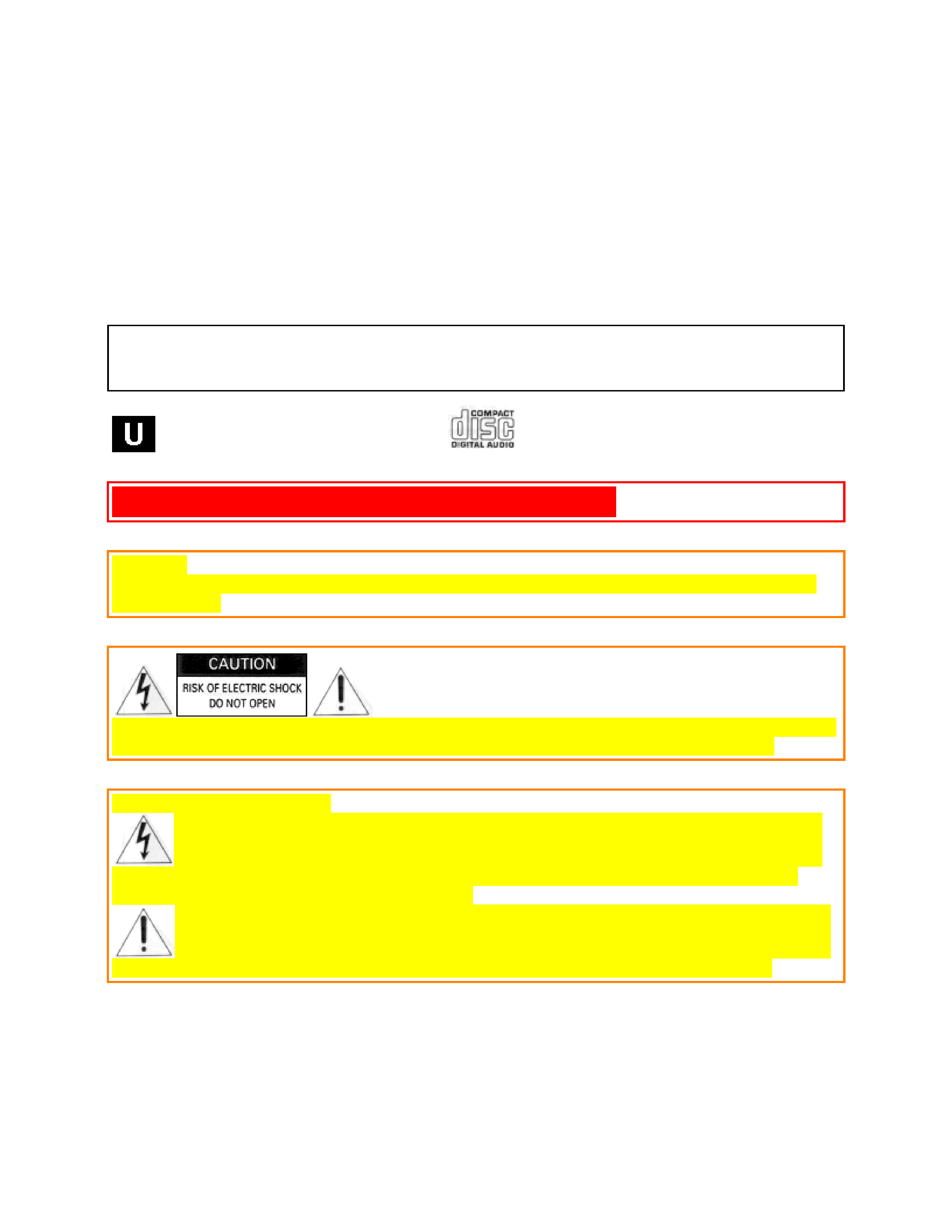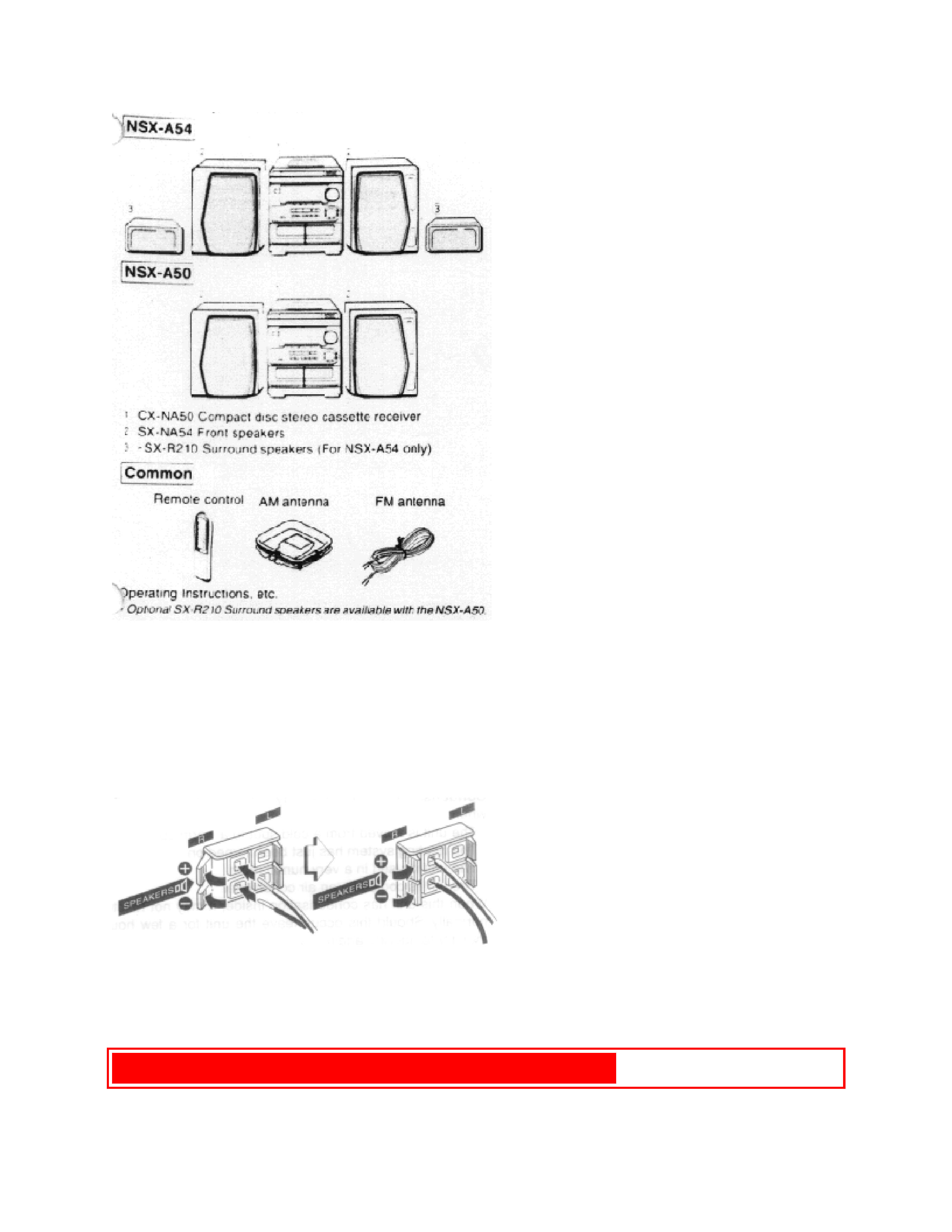
aiwa(1)
COMPACT DISC STEREO SYSTEM
CX-NA50
- For NSX-A54 and NSX-A50
OPERATING INSTRUCTIONS
For Assistance and Information
Call Toll Free 1-800-BUY-AIWA
(United States and Puerto Rico)
English
pg. 1
WARNING
TO REDUCE THE RISK OF FIRE OR ELECTRIC SHOCK, DO NOT EXPOSE THIS APPLIANCE TO RAIN
OR MOISTURE.
"CAUTION: TO REDUCE THE RISK OF ELECTRIC SHOCK, DO NOT REMOVE COVER (OR BACK).
NO USER-SERVICEABLE PARTS INSIDE. REFER TO QUALIFIED SERVICE PERSONNEL."
Explanation of Graphical Symbols:
The lightning flash with arrowhead symbol, within an equilateral triangle, is intended to alert the
user to the presence of uninsulated "dangerous voltage" within the product's inclosure that may be of sufficient
magnitude to constitute a risk of electric shock to persons.
The exclamation point within an equilateral triangle is intended to alert the user to the presence of
important operating and maintenance (servicing) instructions in the literature accompanying the appliance.
Owner's record
For your convenience, record the model number and serial number (you will find them on the rear of your set) in the
space provided below. Please refer to them when you contact your Aiwa dealer in case of difficulty.
Model No.
Serial No. (Lot No.)
CX-NA50

SX-NA54
SX-R210 (NSX-A54 only)
PRECAUTIONS
Read the Operating Instructions carefully and completely before operating the unit. Be sure to keep the Operating
Instructions for future reference. All warnings and cautions in the Operating Instructions and on the unit should be
strictly followed, as well as the safety suggestions below.
Installation
1 Water and moisture - Do not use this unit near water, such as near a bathtub, washbowl, swimming pool, or the
like
2 Heat - Do not use this unit near sources of heat, including heating vents, stoves, or other appliances that generate
heat. It also should not be placed in temperatures less than 5ºC (41ºF) or greater than 35 Cº(95ºF).
3 Mounting Surface - Place the unit on a flat, even surface
4 Ventilation - The unit should be situated with adequate space around it so that proper heat ventilation is assured.
Allow 10 cm (4 in.) clearance from the rear and then tope of the unit, and 5 cm (2 in.) from each side.
- Do not place the unit on a bed, rug, or similar surface that may block the ventilation openings.
- Do not install the unit in a bookcase, cabinet, or airtight rack where ventilation may be impeded.
5 Objects and liquid entry - Take care that objects of liquids do not get inside the unit through the ventilation
openings.
6 Carts and stands - When placed or mounted on a stand or cart, the unit should be moved with care. Quick stops,
excessive force, and uneven surfaces may cause the unit or cart to overturn or fall.
7 Condensation - Moisture may form on the CD pickup lens when:
- The unit is moved from a cold spot to a warm spot
- The heating system has just been turned on
- The unit is used in a very humid room
- The unit is cooled by an air conditioner
When this unit has condensation inside, it may not function normally. Should this occur, leave the unit for a few
hours, then try to operate again.
8 Wall or ceiling mounting - The unit should not be mounted on a wall or ceiling, unless specified in the Operating
Instructions
Electric Power
1 Power sources - Connect this unit only to power sources specified in the Operating Instructions, and as marked on
the unit.
2 Polarization - As a safety feature, some units are equipped with polarized AC power plugs which can only be
inserted one way into a power outlet. If it is difficult or impossible to insert the AC power plug into an outlet, turn
the plug over and try again. If it still does not easily insert into the outlet, please call a qualified service technician to
service or replace the outlet. To avoid defeating the safety feature of the polarized plug, do not force it into a power
outlet.
3 AC power cord
- When disconnecting the AC power cord, pull it out by the AC power plug. Do not pull the cord itself.
- Never handle the AC power plug with wet hands, as this could result in fire or shock.
- Power cords should be routed to avoid being severely bent, pinched, or walked upon. Pay particular attention to
the cord from the unit to the power socket.

- Avoid overloading AC power plugs and extension cords beyond their capacity, as this could result in fire or shock.
PRECAUTIONS (cont.)
pg. 2
4 Extension cord - To help prevent electric shock, do not use a polarized AC power plug with an extension cord,
receptacle, or other outlet unless the polarized plug can be completely inserted to prevent exposure of the blades of
the plug.
5 When not in use - Unplug the AC power cord form the AC power plug if the unit will not be used for several
months or more. When the cord is plugged in, a small amount of current continues to flow to the unit, even when the
power is turned off.
Outdoor Antenna
1 Power lines - When connecting an outdoor antenna, make sure it is located away from power lines.
2 Outdoor antenna grounding - Be sure the antenna system is properly grounded to provide protection against
unexpected voltage surges or static electricity build-up. Article 810 of the National Electrical Code, ANSI/NFPA 70,
provides information on proper grounding of the mast, supporting structure, and the lead-in wire to the antenna
discharge unit, as well as the size of the grounding unit, connection to grounding terminals, and requirements for
grounding terminals themselves.
Maintenance
Clean the unit only as recommended in the Operating Instructions
Damage requiring Service
Have the units serviced by a qualified service technician if:
- The AC power cord or plug has been damaged
- Foreign objects or liquid have gotten inside the unit
- The unit has been exposed to rain or water
- The unit does not seem to operate normally
- The unit exhibits a marked change in performance
- The unit has been dropped, or the cabinet has been damaged
DO NOT ATTEMPT TO SERVICE THE UNIT YOURSELF
TABLE OF CONTENTS
PRECAUTIONS. . . . . . . . . . . . . . . . . . . . . . . . . . . . . . . . . . . . . . . . . . . . . . . . . . . . . . . . . 1
PREPARATIONS
CONNECTIONS. . . . . . . . . . . . . . . . . . . . . . . . . . . . . . . . . . . . . . . . . . . . . . . . . . . . . . .3
REMOTE CONTROL. . . . . . . . . . . . . . . . . . . . . . . . . . . . . . . . . . . . . . . . . . . . . . . . . . .5
BEFORE OPERATION. . . . . . . . . . . . . . . . . . . . . . . . . . . . . . . . . . . . . . . . . . . . . . . . . .5
SOUND
AUDIO ADJUSTMENTS. . . . . . . . . . . . . . . . . . . . . . . . . . . . . . . . . . . . . . . . . . . . . . . .6
GRAPHIC EQUALIZER. . . . . . . . . . . . . . . . . . . . . . . . . . . . . . . . . . . . . . . . . . . . . . . . .6
RADIO RECEPTION
MANUAL TUNING. . . . . . . . . . . . . . . . . . . . . . . . . . . . . . . . . . . . . . . . . . . . . . . . . . . . 7
PRESETTING STATIONS. . . . . . . . . . . . . . . . . . . . . . . . . . . . . . . . . . . . . . . . . . . . . . .7
CD PLAYING
BASIC OPERATIONS. . . . . . . . . . . . . . . . . . . . . . . . . . . . . . . . . . . . . . . . . . . . . . . . . . 9

PROGRAMMED PLAY. . . . . . . . . . . . . . . . . . . . . . . . . . . . . . . . . . . . . . . . . . . . . . . .10
TAPE PLAYBACK
BASIC OPERATIONS. . . . . . . . . . . . . . . . . . . . . . . . . . . . . . . . . . . . . . . . . . . . . . . . . 11
CONTINUOUS PLAY. . . . . . . . . . . . . . . . . . . . . . . . . . . . . . . . . . . . . . . . . . . . . . . . . 12
RECORDING
BASIC RECORDING. . . . . . . . . . . . . . . . . . . . . . . . . . . . . . . . . . . . . . . . . . . . . . . . . .13
DUBBING A TAPE MANUALLY. . . . . . . . . . . . . . . . . . . . . . . . . . . . . . . . . . . . . . . .14
DUBBING THE WHOLE TAPE. . . . . . . . . . . . . . . . . . . . . . . . . . . . . . . . . . . . . . . . . 14
AI EDIT RECORDING. . . . . . . . . . . . . . . . . . . . . . . . . . . . . . . . . . . . . . . . . . . . . . . . .15
PROGRAMMED EDIT RECORDING. . . . . . . . . . . . . . . . . . . . . . . . . . . . . . . . . . . . .16
KARAOKE
MICROPHONE MIXING. . . . . . . . . . . . . . . . . . . . . . . . . . . . . . . . . . . . . . . . . . . . . . .17
KARAOKE PROGRAM. . . . . . . . . . . . . . . . . . . . . . . . . . . . . . . . . . . . . . . . . . . . . . . .18
CLOCK AND TIMER
SETTING THE CLOCK. . . . . . . . . . . . . . . . . . . . . . . . . . . . . . . . . . . . . . . . . . . . . . . .19
SETTING THE TIMER. . . . . . . . . . . . . . . . . . . . . . . . . . . . . . . . . . . . . . . . . . . . . . . . .19
SETTING THE SLEEP TIMER. . . . . . . . . . . . . . . . . . . . . . . . . . . . . . . . . . . . . . . . . . 20
OTHER CONNECTIONS
CONNECTING OPTIONAL EQUIPMENT. . . . . . . . . . . . . . . . . . . . . . . . . . . . . . . . .21
LISTENING TO EXTERNAL SOURCES. . . . . . . . . . . . . . . . . . . . . . . . . . . . . . . . . .21
GENERAL
CARE AND MAINTENANCE. . . . . . . . . . . . . . . . . . . . . . . . . . . . . . . . . . . . . . . . . . .22
TROUBLESHOOTING GUIDE. . . . . . . . . . . . . . . . . . . . . . . . . . . . . . . . . . . . . . . . . .22
SPECIFICATIONS. . . . . . . . . . . . . . . . . . . . . . . . . . . . . . . . . . . . . . . . . . . . . . . . . . . . 23
PARTS INDEX. . . . . . . . . . . . . . . . . . . . . . . . . . . . . . . . . . . . . . . . . . . . . . . . Back cover
CONNECTIONS
pg. 3
Check your system and accessories

Before connecting the AC cord
The rated voltage of you unit shown on the rear panel is 120 V AC. Check that the rated voltage matches your local
voltage
IMPORTANT
Connect the speakers, antennas, and all optional equipment first. Then connect the AC cord in the end.
1 Connect the right and left speakers to the main unit.
Connect the right speaker cord to the SPEAKERS R terminals, and left to the SPEAKERS L terminals.
The speaker cord with the white stripes should be connected to the + terminal and the black cord to the - terminal.
Speaker Hookup Illustration
PREPARATIONS (cont.)
pg. 4
